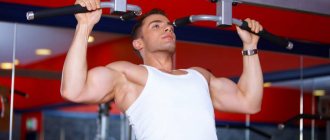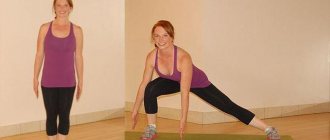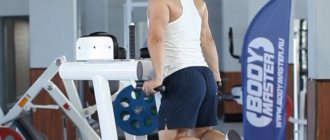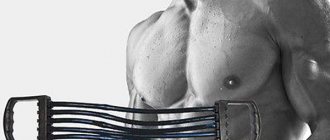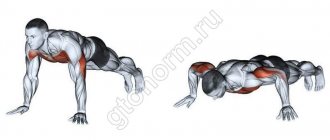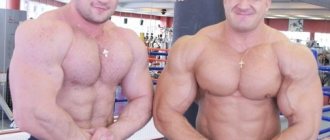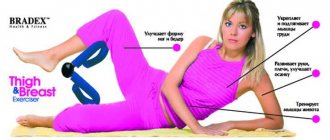Causes of poor development of the inner part of the chest
Oddly enough, most muscle development programs include only those exercises that give full load only to the outer part of the chest, so the athlete has to independently look for information on how to pump up the inner part of the pectoral muscles. After all, a beginner himself cannot determine whether all his muscles are receiving sufficient load.
For this reason, it is recommended to train with a personal trainer. Or if you don’t have enough money, you can take personal training once a month, where the trainer will check whether you are training correctly, and if you deviate from the desired course, he will give his recommendations.
You can also add that you yourself must learn to determine which muscle group this or that exercise is aimed at, and alternate them as needed. A simple example: if you are a swimmer and are doing a bench press exercise, then there is a high probability that the well-developed deltoids take the main load. This is a fundamentally wrong approach to performing the exercise. If you want to achieve good results in the art of building your own body, you definitely need to learn how to transfer all the load from the deltoids to the pectoral muscles. And to do this, you should learn to feel your own muscles. Develop this skill in yourself with each exercise.
Recommendations for exercises
Do not forget that regular training and correct exercise technique are the key to excellent results.
- It is better to start the training with basic exercises, such as push-ups or presses, then move on to those that are more difficult for the joints - dips or pull-ups, and finish with isolated ones - arm raises and raises, butterflies, and so on.
- Never start exercises without warm-up and lead-up approaches. You need to approach the working weight while fully warmed up.
- We perform basic exercises for a small number of repetitions, usually up to 8. And we finish with isolating exercises all the way - about 15 times.
- In order for muscles to grow, you need to gradually make each exercise more difficult. For example, if you do easy push-ups, place a weight plate on your back; If you can do pull-ups well, start doing pull-ups with weights.
Don't forget that muscles don't grow during training, but after it, so give your pectoral muscles time to recover. You can train your chest no more than twice a week. And during the rest period, you need to eat right, eat more protein and get enough sleep.
Nutrition
If you want to know how to pump up the inner part of the pectoral muscles, the main rule is to never neglect nutrition. If possible, try to stick to the diet prepared by your trainer. The balance of proteins, fats and carbohydrates will certainly play a role in building beautiful pectoral muscles. Of the total number of kilocalories eaten, protein should make up 30-35%, 50-60 should be carbohydrates and only 10-20% should be fats. To grow muscle mass, you definitely need to increase the amount of food you consume by 10% compared to your usual diet before you started gaining muscle mass. This is directly related to the large amount of energy you expend during exercise.
Calculating the required calorie content yourself is very simple. It is necessary to multiply your body weight by 30. For example, if you weigh 90 kilograms, then the formula for calculating the required calorie content for you will look like this: 90 x 30 = 2700 kilocalories. To this result we add 10%, that is, 270 kilocalories, and the final value looks like 2970 kilocalories per day. You can calculate your daily diet based on this figure. And thanks to the right diet, you will successfully answer the question of how to pump up the inner part of the pectoral muscles. This is one of the building blocks of a beautiful relief.
Buy only slow carbohydrates, namely buckwheat and pearl barley, basmati, wild or jasmine rice. The carbohydrates contained in these foods are digested slowly and do not lead to a sharp release of insulin into the blood. This way, you will not only provide your body with the substances essential for building muscle mass, but also protect your pancreas.
Now let's look at the best exercises on how to pump up the inner part of the pectoral muscles.
Close grip barbell press
You need to start doing exercises on the inner part of the pectoral muscles from the base. This is one of the most effective exercises for building beautiful muscles. Lie down on an incline bench and grab the bar. The distance between the hands is 10-15 centimeters. It is not recommended to reduce this distance due to the fact that otherwise the barbell will be poorly controlled and you will hardly be able to keep it in a level position to provide the pectoral muscles with an even load. Perform barbell presses with your elbows out to the sides. Ask your partner to back you up so that he controls the even, horizontal position of the barbell.
Lower chest exercises at home
PUSHUPS.
The most accessible exercise that works many muscle groups. It is especially suitable for girls, as it requires minimal skills and its implementation is not too difficult.
To work the lower chest, you need to keep your head higher than your feet. To do this, you can use book stands, increasing their height over time. Place two stacks of books on the floor. Get into the starting position with your feet 15 cm apart, hands on books, palms inward.
You need to move down very slowly and as low as possible. Perform the training very carefully, as books can slip and you can easily injure yourself. You can also use special sports supports as a support; in this case, you can also attach weights.
PUSH-UPS FROM THE BENCH.
Place your hands on the bench with your palms facing inward. Feet apart, back straight. Lower yourself down until your chest touches the bench. You can use a backpack on your back as a weighting device.
PUSH-UPS.
One of the most effective exercises for the lower chest. There are several nuances on how to move the load from your hands to the area you need. When doing push-ups, your torso should be slightly tilted forward and your elbows should be pulled out to the sides, not down.
As you move up, you don't need to straighten your arms all the way. Do the exercise at a measured pace. Over time, you can use weights on your legs.
Push-ups on the horizontal bar.
This load requires experience and skills in push-ups on the horizontal bar. If you are just starting to get acquainted with this equipment, it is better to use a low horizontal bar, approximately at the same level as your head. If you are already a professional, then a regular one will do.
Execution: Place your hands on the horizontal bar at a distance of approximately 25 cm from each other with an overhand grip. You need to forcefully press upward, jumping, and straighten your arms completely. In this case, the lower part of the body should rest against the crossbar. Then you should bend forward slightly and slowly move down, spreading your elbows to the sides. Go as low as possible and repeat.
Push ups
How to pump up your inner pectoral muscles by doing push-ups? Take a lying position with your hands as close to each other as possible. Slowly rise up on your arms, creating maximum load on the pectoral muscles. Since working the chest is important, you don’t have to go too low; the working range is 1/3 of the total distance from the shoulder to the floor. It is recommended to perform 4 sets of 15 repetitions. If the exercise is too easy for you, use additional weights, for example, a backpack with sand.
Exercises
Let's pay attention to:
- close grip barbell press;
- push-ups from the floor (palms facing in);
- lying dumbbell flyes;
- bench press;
- crossover;
- pullover.
Close grip barbell press
These exercises put a lot of stress on the triceps. Therefore, they must be performed before arm training, otherwise you will not be able to fully perform such a press. We start with an empty bar (girls can take a rubberized bodybar for fitness):
- The press is done on a horizontal bench. We lie down so that the bar is opposite the eyes.
- We take hold of the barbell in such a way that there is a distance of 10–15 cm between our hands. You cannot place your hands close to each other - the position is extremely unstable. You will spend all your energy holding the barbell, not doing the exercise.
- The grip is straight, circular. We remove the bar and place it opposite the solar weave. We will lower it between him and the nipples.
- We begin to lower the bar: the elbows go to the sides as much as possible. Lower to the chest while inhaling. As you exhale, lift the barbell up. We always lower it slower than we raise it.
- We do 10–15 repetitions as a warm-up. Then we hang up the working weights. If the working weight is heavy, we approach it in several approaches. That is, if you work with a weight of 80 kg, then we do 5 repetitions with 50, then only proceed to 80 kg.
To pump the middle of the chest, perform 3-4 sets of 8-10 repetitions.
Push-ups, palms inward
This is a very good way to tighten the center of your chest at home. The exercise repeats the bench press with a narrow grip.
It has been experimentally proven that when doing push-ups, a person presses 33% of his body weight. If you weigh 100 kg, then each push-up is equivalent to bench pressing a barbell weighing 33.3 kg.
- We take the emphasis while lying down. The lower back is arched back, the fingers are facing each other. That is, the palms are turned inward.
- We begin to do push-ups so that the elbows go as far as possible to the sides (sideways).
- We do 10–15 repetitions in 3–4 approaches.
You can use a backpack or a partner as a weight, then the number of repetitions will be 6–8. This type of exercise puts a lot of stress on your arms, so be prepared for it.
Lying dumbbell flyes
We lie down on a horizontal bench. Your legs are wide apart and provide you with a stable position. We start with a warm-up approach (dumbbell weight 3–5 kg):
- Hands in front of you, lower them to the side with your elbows down.
- Maintain a slight bend in each arm at the elbow.
- We lower our slightly bent arms as far as possible, with our elbows looking at the floor.
- Attention! In order to lower our arms even lower, we bend in the chest as much as we can. This technique will help load the middle of the chest.
- Pull your arms to the starting position with your chest. There is no need to connect biceps, inertia and other unnecessary things.
- Repeat 12 times for 3-4 approaches.
Bench press
The classic bench press works the entire chest well. To pump the center of the chest, you need to lower the bar to the lower part of the pectoral muscles. At the same time, do not take heavy weights, your technique will suffer.
Remember that you need to press as you exhale and lower the bar as you inhale. This is the base, it is done in 3-4 approaches of 6-8 times.
We remember that you should not become a bridge, lift your pelvis from the bench and turn your head during the exercise. We rest our heels on the floor.
Crossover
We use the upper crossover block:
- We set warm-up weights. We install handles to bring the hands together.
- We take our palms away from ourselves. We put a little body weight on the handles, pushing them forward and down.
- We bend our arms slightly at the elbows. We begin to bring our hands together so that they intersect at a level above the navel. This technique puts more stress on the middle part of the pectoral muscles.
- We bring our hands together. Just touching is not enough range of motion.
- We linger at the point where the arms cross for 1–2 seconds, feeling the tension in the chest.
- Let's go back. We do 15 warm-up reps.
- Set the desired weight and work 3 sets of 10–12 times.
We try to bring our hands together just above the navel. If higher, the upper chest will work. Below is the lower part of the muscles.
This version of the exercise can be performed with one hand. Then you will need 2 times more time for both sides of the chest. Applicable when the other half of the machine is occupied.
A common mistake when performing crossover flyes is incorrect elbow position. Beginners may drop their elbows, extend their arms completely, or bend them too much as the weight increases. The correct placement of the elbows is when they look slightly upward. And the lower you bring your hands, the higher your elbows should look!
Pullover
We do it while lying on a bench. Remember - this is not a strength exercise, so there is no need to chase the scales. We'll tell you why later.
We take a dumbbell weighing 5 kg for warming up. We grasp the dumbbell in the area of the pancake with both hands so that its bar passes between the thumbs and index fingers of each hand. Thus, the dumbbell hangs vertically, its upper part is fixed between the palms, and the lower part hangs above the chest.
- Starting position - the dumbbell hangs freely above your diaphragm.
- The arms are slightly bent at the elbows, the elbows point in opposite directions (if not, the latissimus dorsi muscles work more, reducing the load on the chest).
- Move to the side of the head and behind it. Thus, at the final point the dumbbell will be behind the top of your head and just below the level of the bench. In this position, stretch, try to lower the dumbbell even lower to the floor.
- Then return to the starting position.
This version of the exercise is designed to stretch the muscles, increase the volume of the chest and work out the inner part of the chest. Nuances:
- We do it without jerking, smoothly.
- If you take a lot of weight, at one point your tired deltoid may fail you, and the dumbbell will fall on your face. Therefore, there is no need to take heavy weights. We work with such weight that it is not too heavy. The peak of the load occurs at the exit from the bottom point, and until you reach it, the load is not felt. Therefore, beginners often make this mistake of overweighting.
Pullover
We pump the inner part of the pectoral muscles with a dumbbell. Lie across the bench so that you touch the bench only with your shoulder blades, stretch your arms up and grab a dumbbell, as shown in the photo in the article. Bend your legs at the knees and spread them apart. Raise the dumbbell from behind your head and then place it behind your head. The exercise must be performed slowly and with concentration, then it will definitely be useful to you in deciding how to pump up the inner part of the pectoral muscles.
How to pump up your CHEST muscles - tips from ARNOLD
People always mentioned my pecs when discussing my physique. Since my chest was the best developed part of my body, you can say that I am an expert on the question of “how to build chest muscles.”
Therefore, I would like to discuss with you a couple of methods for improving weak areas of the chest muscles. Many people believe that insufficiently voluminous pectoral muscles are their only drawback.
It is very important to pay attention to other aspects
Let's look at some chest muscle imperfections.
How to pump up the outer part of the pectoral muscles
If your outer chest muscles are not well formed, they will lack that crucial fullness for which I was so famous. My favorite way to hit the outer part was with dumbbell flyes that specifically targeted that area. First, fly the dumbbells as low as possible without risking injury and get as much of a stretch as possible.
Secondly, when returning to the top position, try not to bring the dumbbells together, leave about 30 cm between them (the contact of the dumbbells in the top position eliminates the work of the outer part). Also, to pump up your chest muscles, do dips. This exercise works the outer part perfectly.
Go down as deep as possible and don't go all the way up.
When doing barbell bench presses, use as wide a grip as possible to load the outside. Again, touch the barbell to your chest and try not to straighten your arms completely at the top to maintain tension.
Attention!
Block crossovers are especially good for the inside, as you maintain tension in the muscles when your hands touch each other
In the lower position, it is very important to squeeze the chest muscles. This will create a distinct line down the middle.
You can also use dumbbell flyes and barbell bench presses to target the inner area. For flyes, make the dumbbells touch each other at the top position and tighten your pectoral muscles for 2-3 seconds. When doing presses, simply use a narrow grip (shoulder-width or slightly less) and keep your elbows out to the sides.
Strengthening the upper part of the pectoral muscles
You probably know that incline presses and flyes are great for building your upper chest. It would seem like ordinary exercises, but they can be made special.
I did this by changing the angle of the bench with each set. I started at 15°, then moved up to 25°, then 35° and finally 50°. I very often performed two, sometimes three sets of each bench position.
So no part of my upper area escaped the strain.
I also highly recommend incorporating heavy days into your routine to develop maximum upper chest size. For example, once a week I did super-heavy bench presses and flyes, no more than 5-6 reps per set. In addition, to pump up the chest muscles, I used extra load in my program - drop sets, forced repetitions, rest/pauses.
Dumbbell flyes lying on a bench
Pumping the inner part of the pectoral muscles with the help of two dumbbells begins from a lying position on a horizontal bench. Raise two dumbbells up, keeping your palms facing each other. Next, start raising your arms with dumbbells to the sides. At the peak of the pectoral muscle stretch, you should stop and pause for a couple of seconds, then bring your arms back in the opposite direction. This is the simple answer to the question of how to pump up the inner part of the pectoral muscles with dumbbells.
Features of pumping the middle of the pectoral muscles
Group of muscles involved in movement
While the large muscles in the arms and chest grow noticeably as training increases, the inner portion of the sternum remains the same. The reason is the peculiarities of the anatomical structure of the large muscle, which stretches from the collarbones to the abs. It is not possible to visually divide it in order to pump the internal and external areas separately. The problem is complicated by the natural depression in the middle of the human body, where the breastbone passes. It may seem that the inner part of the chest does not work at all and all training is useless. The solution to the problem is to pump up all the pectoral muscles so that the increased relief closes the cavity and creates the desired effect of a pumped up, muscular body.
Most presses, rows and inclines involve only the pectoralis major muscle, while the peripheral fibers remain unoccupied, which negatively affects their development. You can correct the situation using standard exercises, changing the tilt of the body, increasing the load, adjusting the position of the hands and other important nuances that shift the emphasis closer to the center of the chest.
Depending on the anatomical structure, the depression in the center of the pectoral muscles can be significantly pronounced
In some cases, it is not possible to achieve pronounced muscularity in the midline of the sternum. There are two reasons for this phenomenon:
- The muscle mass of the athlete’s body is not sufficiently developed. The chest appears flat, the depression in the center is more pronounced. The way out of the situation is to perform special exercises designed to pump up the thoracic muscles: bench press on an inclined or horizontal bench with a barbell or dumbbells of suitable weight. After a few weeks of training, positive results will be visible to the naked eye.
- Genetic features of body structure can negatively affect training results. The solution is to find suitable exercises that can “get” to the inner part of the chest muscles. You will need to consult several specialists who will give advice based on their own practical experience. In any case, the situation is fixable. The athlete will only need willpower and patience to achieve tangible results.
Some trainers believe that the expression “inner chest muscles” has no basis in reality. They claim that the pectoralis major muscle occupies the entire sternum, and it is impossible to pump up only a certain part of it. Perhaps this opinion has a practical basis: comprehensive development of the pectoralis major muscle will invariably entail the development of all its sections, including the middle part.
note
In pursuit of rapid development of lagging muscles, many athletes make a fatal mistake - they begin to create too high a load for them, which in plans should help them quickly catch up with another, more developed muscle area. But this is the wrong approach, because in this way you run the risk of overtraining certain muscle areas. To understand how this can affect a muscle, let's look at how the process of building muscle occurs in general.
During training, muscle fibers become tense to such an extent that microdamages are formed in them, which are overgrown with new muscle tissue during rest days. If you overdo it during the training process, you will create too many microdamages, which, firstly, will take a long time to heal, and secondly, they may be overgrown with less muscle tissue, that is, the muscle volume will even decrease. Is this your goal? Of course not. Therefore, we recommend introducing 1-2 additional exercises to the lagging muscle area so that you do not cause harm to your health.
It should be noted that at some point in your training, you will again begin to notice how muscle growth will slow down or stop altogether. This will be a reason to replace the exercise with a similar one. The fact is that muscles quickly get used to the same type of load. So much so that even an increase in the weight of the projectiles stops developing them. In this article you will find a list of exercises that will allow you to modify your training program several times.
